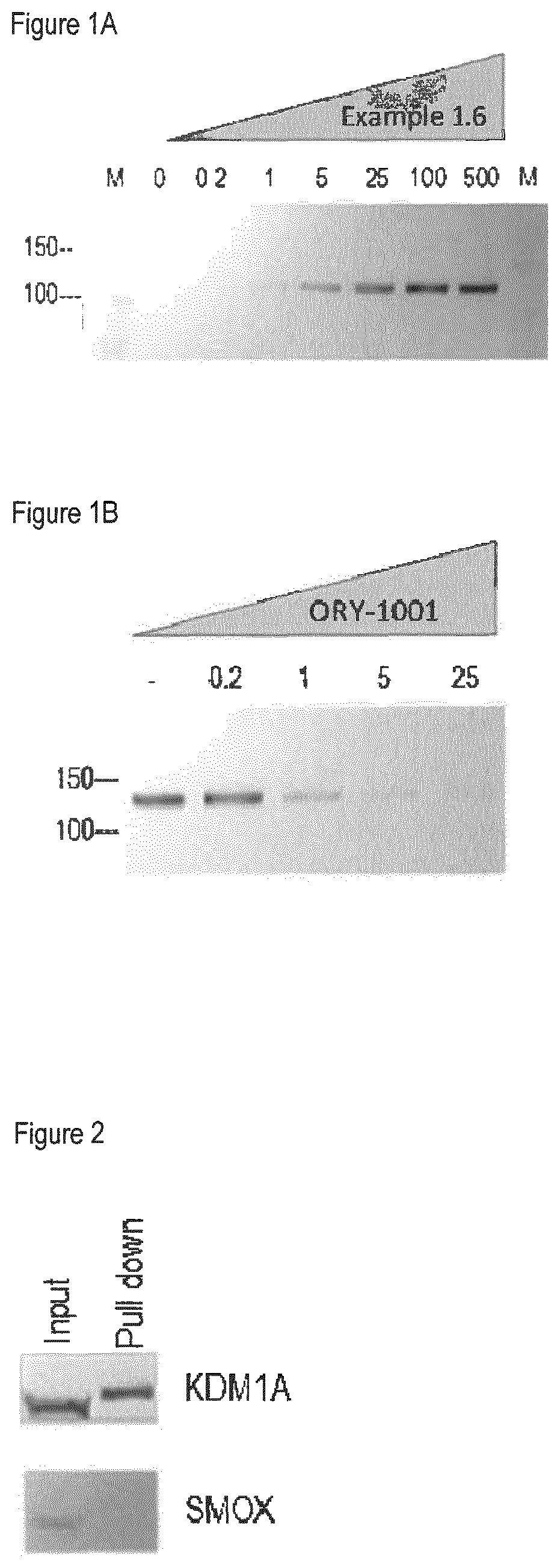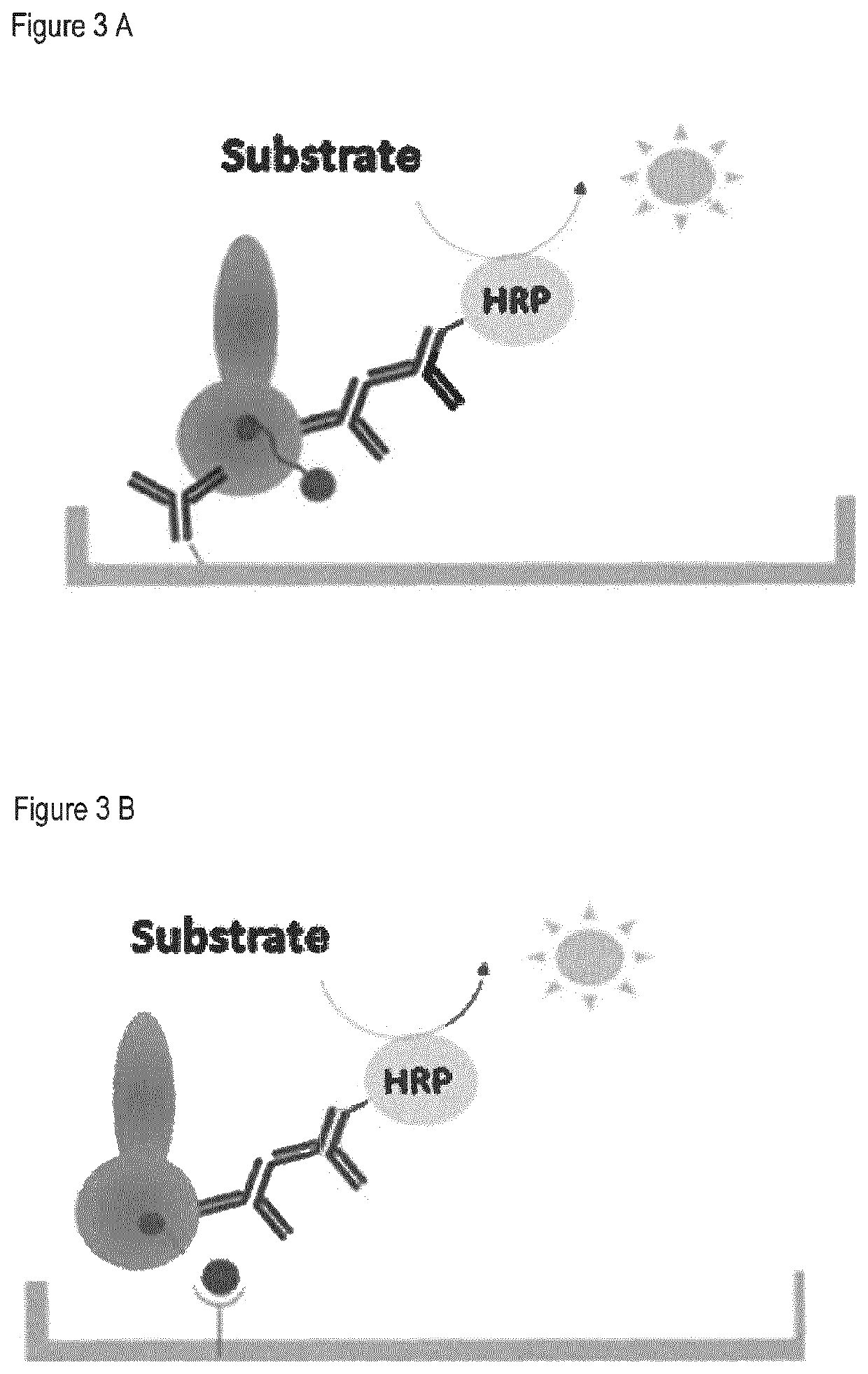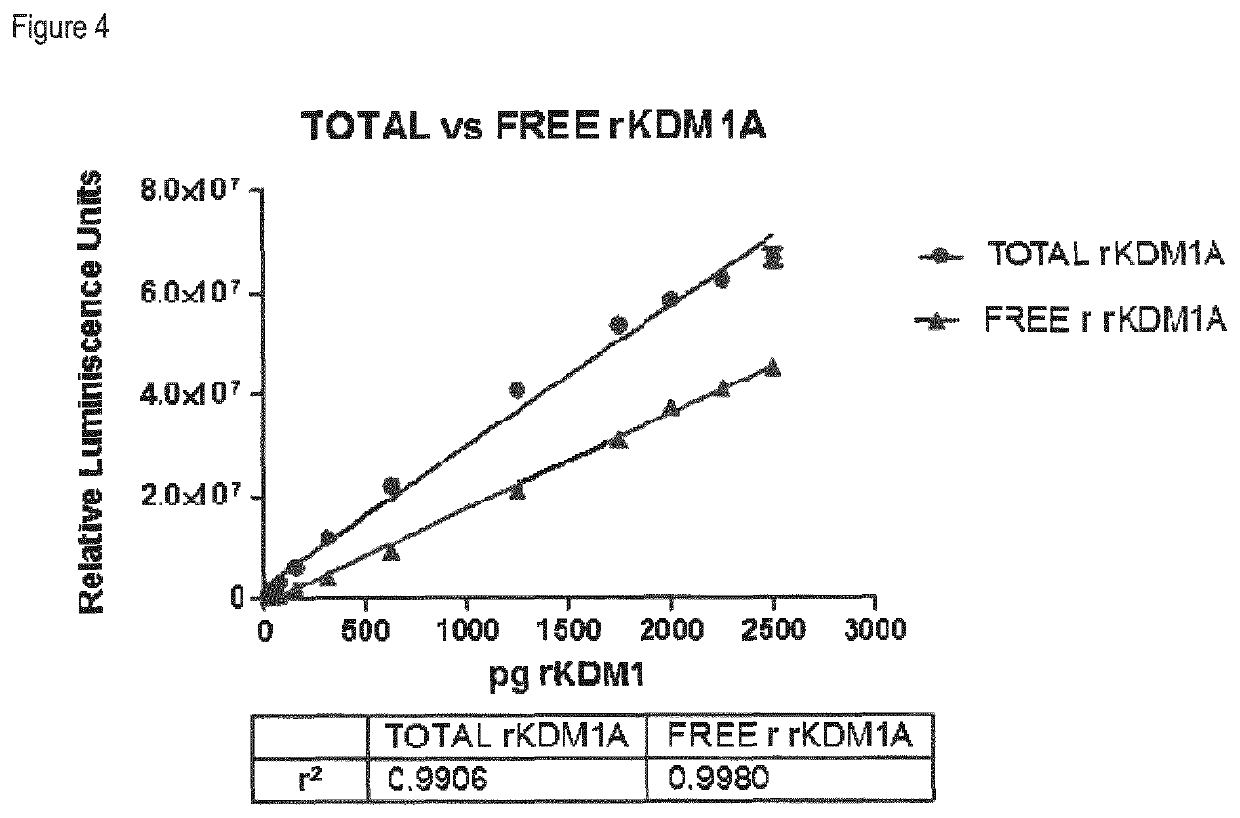Methods to determine KDM1A target engagement and chemoprobes useful therefor
a chemoprobe and target engagement technology, applied in the field of methods to determine the kdm1a target engagement and chemoprobes useful therefor, can solve the problem that the application of samples obtained from animals or human subjects is not easy
- Summary
- Abstract
- Description
- Claims
- Application Information
AI Technical Summary
Benefits of technology
Problems solved by technology
Method used
Image
Examples
example 1
Synthesis of Chemoprobes
[1680]One of the following methods was used for the determination by LC-MS:
[1681]Method 1: Column: Xbridge C18 (100 mm×4.6 mm, 3.5 um); Mobile Phase: A: Acetonitrile, B: 0.01 M Ammonium Bicarbonate in Water; Gradient: Time / % A: 0 / 5, 315, 10 / 80, 12 / 90, 15 / 90, 15.1 / 5; Flow Rate: 1.0 mL / min; Diluent: Acetonitrile:Water (70:30)
[1682]Method 2: Column: Aquity UPLC BEH C18 (50 mm×2.1 mm, 1.7 um); Mobile Phase: A: 0.05% Formic Acid in Water B: 0.05% Formic Acid in Acetonitrile; Gradient: Time / % A: 0 / 97, 0.3 / 97, 3.2 / 2, 3.8 / 2, 4.3 / 97, 4.5 / 97; Column Temp: 35° C.; Flow Rate: 0.6 mL / min
[1683]Method 3: Column: Aquity UPLC BEH C18 (50 mm×2.1 mm, 1.7 um); Mobile Phase: A: 0.1% Formic Acid in Water B: 0.1% Formic Acid in Acetonitrile; Gradient: Time / % B: 0 / 3, 0.4 / 3, 3.2 / 98, 3.8 / 98, 4.2 / 3, 4.5 / 3; Column Temp: 35° C.; Flow Rate: 0.6 mL / min
[1684]Method 4: Column: Xbridge C18 (100 mm×4.6 mm, 3.5 um); Mobile Phase: A: Acetonitrile, B: 0.01 M Ammonium Bicarbonate in Water; Gradien...
reference example 1
3-(4′-((trans)-2-((tert-butoxycarbonyl)((trans)-4-((tert-butoxycarbonyl)amino)cyclohexyl)amino)cyclopropyl)-[1,1′-iphenyl]-3yl)propanoic acid
Step 1: Preparation of tert-butyl ((trans)-4-(((trans)-2-(4-bromophenyl)cyclopropyl)amino)cyclohexyl)carbamate
[1693]Tert-butyl 4-oxocyclohexylcarbamate (22.1 g, 0.104 mol) was added to a solution of trans-2-(4-bromophenyl) cyclopropanamine (22 g, 0.104 mol) in DCE (400 mL) at 0° C., followed by the addition of AcOH (1.6 mL), and the mixture was stirred at the same temperature for 5 min. Sodium triacetoxy borohydride (40 g, 0.187 mol) was slowly added portions wise at 0° C. and the mixture was allowed to stir at RT for 16 h. The progress of the reaction was monitored by TLC. After completion, the reaction mixture was poured into saturated aq. NaHCO3 solution (100 mL) and extracted with DCM (2×200 mL). The combined organic extracts were washed with water (100 mL), brine (100 mL), dried over anhydrous Na2SO4, filtered and filtrate was evaporated t...
reference examples 2-4
[1700]The following compounds were obtained by following the procedure described in reference example 1, but using suitable starting materials.
[1701]
RefLC-MSRtExampleNameStarting materialmethod(min)m / z23-(4′-((trans)2-((tert-trans-2-(4-82.96562.9butoxycarbonyl)(1-(tert-bromophenyl)cyclopropanamine(M − H+)butoxycarbonyl)piperidin-4-and tert-butyl 4-yl)amino)cyclopropyl)-[1,1′-oxopiperidine-1-biphenyl]-3-yl)propanoic acidcarboxylate33-(4′-((trans)-2-((tert-trans-2-(4-83.01576.8butoxycarbonyl)((1-(tert-bromophenyl)cyclopropanamine(M − H+)butoxycarbonyl)piperidin-4-and tert-butyl 4-yl)methyl)amino)cyclopropyl)-formylpiperidine-1-[1,1′-biphenyl]-3-carboxylateyl)propanoic acid43-(4′-((1S,2R)-2-((tert-(1R,2S)-2-(4-103.30601.4butoxycarbonyl)((trans)-4-bromophenyl)cyclopropan-(M + Na+)((tert-1-amine andbutoxycarbonyl)amino)cyclohexyl)amino)cyclopropyl)-tert-butyl 4-[1,1′-biphenyl]-3-yl)propanoicoxocyclohexylcarbamateacid
[1702]The reference examples 1, 2, and 3 are a mixture of 2 isomers, whi...
PUM
| Property | Measurement | Unit |
|---|---|---|
| temperature | aaaaa | aaaaa |
| temperature | aaaaa | aaaaa |
| pH | aaaaa | aaaaa |
Abstract
Description
Claims
Application Information
 Login to View More
Login to View More - R&D
- Intellectual Property
- Life Sciences
- Materials
- Tech Scout
- Unparalleled Data Quality
- Higher Quality Content
- 60% Fewer Hallucinations
Browse by: Latest US Patents, China's latest patents, Technical Efficacy Thesaurus, Application Domain, Technology Topic, Popular Technical Reports.
© 2025 PatSnap. All rights reserved.Legal|Privacy policy|Modern Slavery Act Transparency Statement|Sitemap|About US| Contact US: help@patsnap.com



